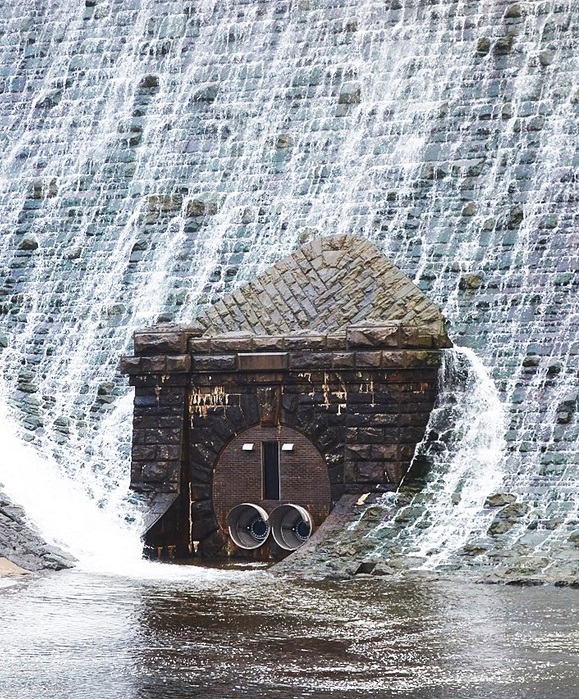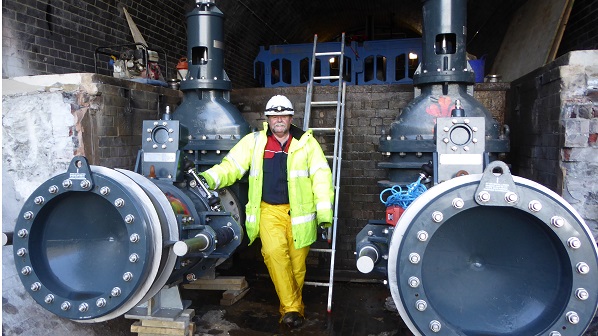



 What's the story?
What's the story?
Despite nature's undeniable beauty, it has never been an easy thing to control. This is an ever-present challenge when dealing with dams and reservoirs, and can be identified throughout the various stages of our Caban Coch case study.
Elan Valley, Wales, exemplifies how natural beauty can both be harnessed and preserved by man. Characterised by diverse flora and fauna, and awash with seasonal colour, the area is treasured by conservationists and tourists alike. Therefore, the six Victorian dams built across the Elan Estate must be handled with the utmost care and consideration in order to protect the surrounding environment.
Caban Coch, the lowest dam in the sequence, resonates with its surrounding beauty in its resemblance of a natural waterfall when full. For over 100 years, this dam has played a crucial role in carrying clean water 73 miles from Wales to Birmingham. The dam has four discharge lines, 600 mm diameter each, and their function is to meet Birmingham's water demands, release compensation flow downstream for the benefit of the environment, enable the dam to drain down quickly in case of emergency, and power a small turbine which generates electricity for the benefit of the local community.
Nature's first test came in 2016, when the discharge capacity was found to be affected due to silt that had built up over the past 15 years in the left-hand scour line. The problem was further aggravated by ageing valves which were reaching the end of their life thus reducing the overall degree of control available to dam engineers regarding the discharge capacity. Potential damage to the environment was therefore becoming inevitable, and the problem had to be addressed. Instead of discharging the silt through the unused valves and endangering wildlife downstream, Welsh Water had to employ a group of divers who took almost 6 months to clear the silt. Particularly challenging aspects of the process were that there was almost zero visibility, and the dive was so deep that a decompression chamber was required on site. Following its clearance,
the Blackhall valvologists®; UK Valve Manufacturer was called in to inspect the site, assess problems and offer a proposal for upgrading and enhancing equipment.
Immediate Problems:
An inspection survey was carried out by our valvologists®. The crucial challenge was coming up with a sympathetic solution not only to the environment but also with the conservation and beauty of the dam, since the fascia of the valve chamber and the Victorian-built bridge below it were listed. The combination of ageing gate valves used for isolation and flow control wasn't an ideal set up, as gate valves are not for dedicated flow control. Using only gate valves for flow control can lead to turbulence and inaccurate discharge capacity which can further cavitate the entire piping and valve arrangement.
As a result, the discharge system could fail if not upgraded with the right selection and combination of valves. After considering all the challenges, external factors and various technical aspects, we offered Welsh Water a comprehensive technical proposal which would not only boost the discharge capacity but also increase the degree of control that Caban Coch would have on each of the four discharge lines. Our offer was centred around the 100-year asset life valves, an economically and environmentally sound initiative that will keep Caban Coch's discharge mechanism in top condition for at least another 100 years.
Specifically, the recommendation was to use a dedicated flow control valve i.e. a fixed cone valve (downstream), and a gate valve (upstream) for isolation. It included the design and manufacture of four DN600 fixed cone flow control valves and four DN600 isolation gate valves. Additionally, our proposal comprised a detailed 3D structural drawing which showed Welsh Water how the valves would be arranged in the chamber in a way which would comply with all the spacing and safety standards. A key consideration was that the discharge footprint had to be designed in such a way that its dispersal pattern wouldn't hit and damage the surrounding Victorian architecture, including the bridge at the base of the dam. This was accomplished by fine-tuning the hoods and the inclination angles to guide jets into the safe zone of the stilling basin by achieving the perfect angle of incidence.
Here at Blackhall, we understand how crucial the performance of each valve is for the safety of the surrounding environment. With such large volumes of water at stake, there is huge potential for catastrophic damage.
Blackhall is proud to be leading the initiative in creating 100-year asset life valves. By prioritising quality in design and materials, and pairing that with the unrivalled experience and knowledge of personnel, creating 100-year valves becomes more than just a pipe dream.
The immediate benefit of purchasing these valves lies in Total Expenditure, or TOTEX.
For example, while at face value a 100-year valve costs more than an imported valve, the cumulative costs associated with continuously repairing and replacing the cheaper valve end up far exceeding the cost of the 100-year valve. Not only does this benefit the asset owner in the long term, but it also massively benefits the environment. Taking all aspects of manufacturing and transporting new and often foreign valves manufactured in East Asia into account, it becomes evident that the carbon footprint is shockingly higher. The high-quality and therefore low-maintenance design of Blackhall valves and our utilisation of a local supply chain contribute to our goal for a lower carbon footprint.
To briefly conclude, Blackhall provides customers with the ultimate peace of mind overthe life cycle of their assets, massively decreasing the chance of failure and consequent environmental impact. A certain peace of mind is also given by the environmentally-conscious decisions taken and followed by Blackhall.
Selecting Blackhall to design and manufacture their valves was wholly consistent with Welsh Water's target to reduce their carbon footprint by 2020. This responsible decision demonstrates the alignment of the corporate philosophies of Blackhall and Welsh Water for the benefit of generations to come. In a final ode to the Elan Valley, the valves were sympathetically painted in Welsh slate grey and emblazoned with a Welsh Dragon, in keeping with Caban Coch's natural and historical setting.
